In the alternate worlds of Muv-Luv Unlimited/Alternative, Tactical Surface Fighters are only the tip of the spear of humanity's fighting force, with support vehicles, warships, aerial craft, and aerospace vehicles augmenting the deadliness of TSFs on the field either directly or indirectly.
Naval craft provide an important aspect of warfare against the BETA, ranging from transporting TSFs into the thick of the fray, to providing cover support, and even refueling and rearming TSFs within the span of a few minutes. As they are seldom expected to fight head-on against BETA, most warships are focused on bringing their firepower to bear as accurately and as quickly as possible, while assault ships are built to quickly land forces and provide able backup and tactical control.
Warships range from old battleships to modern frigates and well-armed destroyers; however, all are capable of bringing heavy firepower to bear against the BETA. From the impressive fusillades of the Yamato-class battleships to the advanced missile systems of the Ticonderoga-class Cruiser , warships are intended to reduce the area they target into a smoking plain, either to clear the area for troops to land and prepare to face the next relentless wave of BETA without interruption, or to cover a desperate retreat by beleaguered allies.
Japanese Warships[]
Tsushima-class Gunboat[]
Ships of the line: Others
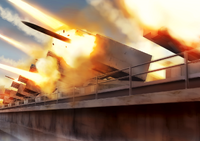
(MLA) A Tsushima-class initiating support fire with its numerous MRLS emplacements.
- A large supertanker ship modified to carry numerous Multiple Rocket Launch Systems, the Tsushima-class gunboat is closely related to the Ōsumi-class TSF Landing Ship in that both use the same modified supertanker design as their basis.[1]
- The Tsushima-class was present during Operation 21st , providing surface-based rocket fire in supporting allied forces in their shore landing on Sadogashima.
Yamagumo-class Destroyer[]
Ships of the line: Others
- A light destroyer, the Yamagumo-class is a relatively new addition to the Imperial Navy. One such vessel was part of the interception fleet at the Invasion of Niigata in 2001.
Mogami-class Cruiser[]
Ships of the line: Mogami, Mikuma

(MLA) Mogami keeping pace with other ships.
- The Mogami-class cruisers, displacing a little under 30 000 tons, are high-speed warships with three 30.5cm three-barreled gun turrets as their main armament.[2]
- With a structural arrangement and similarity to heavier battleships, excellent command and control capabilities, as well as having cruising capabilities and high speed, the cruisers were also capable of serving in a flagship role;[2] Mogami acted as both the flagship of the IJN forces present, as well as for the IJA's Whiskey Unit, during Operation 21st.[2]
- Her sister ship, Mikuma, is noted for her slight physical difference from Mogami, having been used as a prototype for anti-laser construction while work was being carried out on the Kii-class battleships.[2]
Yamato-class Battleship []
Ships of the line: Yamato (大和), Musashi (武蔵), Shinano (信濃), Mino (美濃)
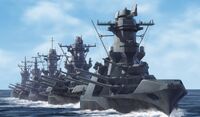
(MLA) A fleet of Yamato-class battleships during Operation 21st.
- The Yamato(大和)-class battleship, the famed battleship class of Imperial Japan during World War II, these four warships, initially planned as battleships, from the construction of Mino and Kaga onwards, first had some of their heavy armor removed to match speed with carrier groups as combat escorts, and were later refitted with more anti-aircraft weapons due to the increasing threat of naval aircraft.[3] Spared from the decommissioning of numerous IJN capital ships when the Japanese were defeated in 1944, the Yamato-class continued to serve the Japanese navy during the Cold War period. As naval technology improved, the warships were then scheduled for decommissioning.[3]
- In the 1970s, the BETA advance resulted in the IJN bringing the Yamato-class warships back into active service. The current Yamato-class ships have gone through extensive refitting; external appearance, gun systems, and armor have been overhauled, improved, and replaced, with firing guidance systems utilizing satellite data-link, close-in anti-laser defences launched by VLS, and an anti-laser coating on its hull.[3]
- The Yamato-class would participate in numerous battles when the BETA reached Japan, and were present when the island of Sadogashima was lost to the BETA advance.
Their next notable operation would be at the Operation 21st, providing valuable artillery support to the TSF forces on the island.
The Yamato and Shinano were engaged in combat operations during the 8th Border War, but did not engage any enemies.
Yamato Kai-class Battleship[]
Ships of the line: Izumo (出雲), Kaga (加賀)
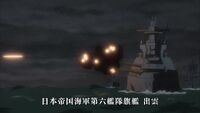
(TE An.) The Izumo at Tsushima Strait, firing a full broadside barrage at BETA island-hopping from the Korean Peninsula.
- A variant design of the Yamato-class battleship design dating back to World War II, the Yamato Kai(改大和)-class was originally planned as a hull conversion of the fifth and sixth Yamato-class ships into large open-deck aircraft carriers to replace those that had been lost in combat against US forces during World War II.[4] However, when the cost of such a conversion was deemed to be costlier than a new carrier construction, the design of the ships were instead modified into, and built as, aviation battleships, with their third gun turret, located towards the stern of the ship, removed to make space for a hangar and a flight deck.[4]
- While the usefulness of the Yamato Kai-class was called into question during its construction, the ships, which survived the decommissioning of much of the IJN's surviving capital ships following the Japanese surrender in World War II, proved themselves as able helicopter carriers in the time period in-between the end of World War II and the BETA War, while retaining their naval gunfire support roles, and were regarded as highly useful vessels.[4] When the BETA War came about, the Yamato Kai-class ships received upgrades similar to those given to the Yamato-class, including the removal of angular surfaces from the ships' overall profile, and the application of anti-laser hull coating, the addition of a large-scale VLS.[4]
- The Yamato Kai-class warships, together with the Yamato-class battleships and the Kii-class super battleships, would become a portion of the IJN's main strength.[4] Notable deployments include the Izumo, which was under the command of Admiral Yammaguchi and used its powerful guns to provide support fire during the Defence of Kyoto in 1998, and later during the Defence of Yokohama Base in 2001. Kaga was part of the second naval battlegroup during Operation 21st.
Kii-class Battleship[]
Ships of the line: Kii (紀伊), Owari (尾張)
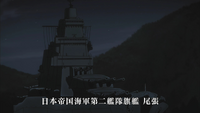
(TE An.) Owari, stationed in Lake Biwa during the Defence of Kyoto.

(TE An.) The Owari alongside a TSF carrier stationed in Lake Biwa.
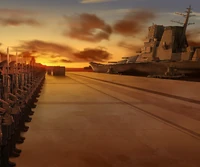
(MLA)A Kii-class can be seen in the background.
- Developed as a successor to the Yamato-class battleships, the Kii-class battleships were originally intended to match the US Navy's Montana-class battleships in all aspects, with construction beginning in 1941.[5] Work on the Kii-class stalled at the end of World War II, with 60% of the first ship completed, but was eventually restarted in short order by both the Imperial Japanese Navy and their new allies, the USA, as a defence against the emerging Soviet Union and her communist allies.[5] Supported by the US Navy, the Kii-class was then envisioned to match the Soviet Navy's Sovetsky Soyuz-class battleships, and construction was then completed with that train of thought.[5] The first ship, Kii, was completed in 1949; the second, Owari, was completed in 1951. Plans for the construction of two more ships, Kai (甲斐), and Suruga (駿河), were cancelled, leaving Kii and Owari as the only two examples of their kind.[5]
- The Kii-class' original main armament were three double-barreled 50.8cm gun turrets; upgrades to the design prior to the end of WWII, made to surpass the specifications of the Montana-class, resulted in the final fitting of four triple-barreled 50.8cm gun turrets as its main armament. The ship type, in total, displaced 110,000 tons, making it the heaviest surface combatant ship in history.[5]
- Both Kii and Owari served in rotations as the flagship of the IJN Combined Fleet, receiving numerous anti-air and anti-submarine upgrades before both ships were placed in reserve duty, and moored at Kure.[5] The beginning of the BETA invasion of Earth in 1974, however, saw both ships returned to active duty as part of the IJN's main fleet. After a deployment to the Indian Ocean in 1992, both Kii and Owari returned to Japan for upgrading; over the span of a year and a half, both were refitted with satellite data-link capabilities and guided missile systems, as well as anti-laser hull coatings, structural reinforcements, and armor. In 1995, both ships returned to active duty.[5]
- Both Kii and Owari participated in numerous operations in the defence of Japan during the 1998 BETA Invasion of Japan; Owari acted as the flagship of the Second Fleet, which at that time was stationed at Lake Biwa to provide fire support. Both ships also served during the start of Operation Lucifer, the Defence of Yokohama Base, as well as numerous other key operations.[5]
American Warships[]
Oliver Hazard Perry-class Frigate []
Ships of the line: USS Vandegrift, Others
- A ship intended for multiple battlefield roles, the Oliver Hazard Perry-class is a frigate designed to support both naval and landing operations. One such ship, the Vandegrift, was sunk during the massive gravitational anomaly that swept the John F. Kennedy and its escort vessels off-course.
Ticonderoga-class Missile Cruiser[]
Ships of the line: Gettysburg, Others
- The Ticonderoga-class missile cruiser is a naval warship of the US Navy. A marked departure from the typical battleship, its main armaments are missiles launched by VLS, allowing it to fire powerful guided cluster munitions against BETA hordes.
Zumwalt-class destroyer[]
Ships of the line: King, Others
- A relatively modern warship, the Zumwalt-class is a high-speed assault destroyer class of the US Navy.
Iowa-class Battleship[]
Ships of the line: Iowa, New Jersey, Missouri, Wisconsin, Illinois, Kentucky
- The Iowa-class battleships are a class of high-speed battleships built during World War II. A new model of warship for its time, their construction was made possible by Japan's withdrawal from the London Naval Treaty, and the treaty's subsequent collapse.[6] With a standard displacement of 45 000 tons, the Iowa-class had a complement of 40.6cm three-barreled main turrets (for a total of nine cannons). While its armament was smaller than that of the comparable IJN Yamato-class battleships, the Iowa-class' main guns usage of heavier ordnance gave them increased firepower.[6] The Iowa-class' high speed also allowed the ships to serve as carrier group escorts, and together with the Montana-class battleships, both US Navy battleships types clashed with the IJN's Yamato-class and Nagato-class battleships several times over the course of World War II. The Iowa-class battleships also took on a myriad of duties during this period, from direct battle to shore bombardment.[6]
- After World War II, the USA's focus on the development of space-borne assets and the establishment of the Space Corps meant that constant maintenance of high-cost assets were no longer a possibility.[6] One of these assets was the Iowa-class battleships; the costs were shared with the Empire of Japan as part of the US-Japan Mutual Security Treaty, and the ships were placed into the reserve fleet.[6]
- When the BETA War broke out in 1974, the Iowa-class battleships were brought out of reserve and back into active service. Upgrades to the ships included cruise missile launch capabilities, anti-BETA defences and optimizations, and other upgrades.[6] From then on, the Iowa-class served almost exclusively as a core component of the UN Fleet, as stipulated under the UN Charter, Section 43. The ships participated in operation theaters worldwide, from the Mediterranean Sea, to the Indian Ocean, and the Sea of Japan.[6] In particular, Iowa, New Jersey, Missouri, Illinois, and Kentucky are a part of the United Nations Pacific Fleet, based in Sasebo Base, in Japan.[7]
Montana-class Battleship[]
Ships of the line: Montana, Ohio, Maine, New Hampshire, Louisiana
- A new class of battleships intended as a replacement for the Iowa-class, the Montana-class was designed as part of a new set of tactics to form the core of a strike group alongside American carriers. One such strike group was centered around the Mediterranean area, intended for offshore support of European war efforts against the BETA.
Soviet Warships[]
Slava-class Cruiser[]
Ships of the line: Others

(TE VN) A Slava-class cruiser.
- A warship class of the Soviet Navy. Its main armament are sixteen launcher tubes, allowing for a withering hail of rocket artillery.
Sovetsky Soyuz-class Battleship []
Ships of the line: Sovetsky Soyuz, Sovetskaya Ukraina, Sovetskaya Rossiya, Sovetskaya Belorussiya
- A World War II-era battleship design, the Sovetsky Soyuz-class had a displacement of 61 510 tons and carried three three-barreled 40.6cm gun turrets as their main armament.[8] Construction on the ships, which had began in 1938, had been halted due to the Russon-German War during World War II, due to the need for the urgent expansion of the Soviet Army against the invading German forces.[8] During this period, the partially-completed Sovetskaya Ukraina was seized by the Germans, and eventually destroyed, leaving the Soviet Union with three partially-completed ships of this class.[8]
- After the end of World War II, construction on the ships were restarted, and completed, some time before the Korean War, in order to counter the strength of the US Navy/Imperial Japanese Navy.[8] However, lack of relevant knowledge on the building of large-scale warships, especially in the construction of large-bore naval cannons, resulted in a delayed construction schedule, and issues with the ships continued after their commissioning.[8]
- After the BETA War began on Earth, the ships, which were unable to participate due to the inland nature of the conflict, were considered for decommissioning numerous times.[8] However, when the BETA advance reached far enough to threaten locations closer to the continental shorelines of Eurasia, the Sovetsky Soyuz-class ships were finally able to display their firepower in various hectic battles, saving the lives of numerous military personnel and civilians.[8] With the need for support firepower from these ships recognized by the Soviet Armed Forces, the Sovetsky Soyuz-class battleships were assigned to the defence of the Sea of Okhotsk and Soviet defence in the Far East.[8]
- Sovetskaya Rossiya is currently deployed to the Kamchatka Peninsula to provide firepower support.
Udaloy II-class Destroyer[]
Ships of the line: Others
- A warship class of the Soviet Navy.
Australian Warships[]
Hobart-class Destroyer[]
Ships of the line: Sydney, Others
- A modern destroyer of the Royal Australian Navy, the Hobart-class is capable of dishing out incredible amounts of firepower with its VLS and naval cannon. One ship, the Sydney, was a UN liaison accompanying the USS John F. Kennedy on its mission against the Cheorwon Hive, and later served as a fleet member of the JFK Naval Garrison Base's ship complement. Despite its immobility caused by a critical shortage of fuel, the ship's powerful armament served the defenders JFK Base well.
European Warships[]
[]
Lion-class Battleship[]
Ships of the Line: Lion, Temeraire, Conqueror, Thunderer, others
- A World War II Battleship of the Royal Navy, after the end of World War II the class of battleships was scheduled to be scraped or decommissioned. The Battleships of the Lion-class are armed with three 40.6cm cannons in triple turrets with each turret fitted with triple barrels of these guns. However the Soviet Union was considered a major threat to British interests, but the BETA War broke out in 1974 and the battleships were continuously upgraded to protect itself with anti-laser armor. In 1983 one of the Lion-class ships participated in Operation Neptune, along with a Montana- and Iowa-class Battleships.
EESA/Warsaw Pact Warships[]
Volksmarine[]
H-class Battleship[]
Ships of the Line: Karl Marx, Fuhlendorf
- Warships of the East German Navy that participated in Operation Neptune. Its unknown how long the main guns of these ships are and what class they belong to. Karl Marx is the Flagship of the GDR Navy, the other Fuhlendorf was sunk by Laser class BETA during the operation.
Trivia[]
- The real-world history of the Yamato-class battleship line was much less lasting than their Muv-Luv counterparts. Yamato and Musashi were sunk during WWII. Shinano was modified into a carrier, and two other warships were planned and later scrapped and abandoned; Mino never existed.
- The Tsushima-class gunboat is a fictional ship class; no such vessel type existed within the real-world historical Imperial Navy, or with the current Japanese Maritime Self-Defence Forces.
- The Mogami-class cruiser in Muv-Luv is referred to being the third ship to hold that name. However, the ship in Operation 21st is clearly that of a World War II-era Mogami-class cruiser, the second known ship/ship type to use the name of Mogami; in reality the third user of the Mogami name was an Isuzu-class destroyer escort.
- The Yamato Kai-class is a fictional battleship class; its ship type, however, was that of an aviation battleship/carrier battleship, of which several examples, like those of the Ise-class battleships, exist. Izumo was actually a cruiser, while Kaga existed as an aircraft carrier. But in the modern real world, Izumo and Kaga become Izumo-class multi-purpose destroyer or a helicoper carrier and in 2021, its have been converted into Aircraft Carrier
- The immense firepower and all-rounded capabilities of the Kii-class appears to be a reference to the unbuilt A-150 class of warships in the real world; both the A-150 design and the Kii were originally intended to be equipped with dual-barreled gun turrets (51cm for the A-150, 50.6cm for the fictional Kii), both were designs ready for construction in 1941, and both were intended to counter the Montana-class battleship design.
- Of all four Sovetsky Soyuz-class battleships in the Muv-Luv universe, none of which were ever completed in the real world, only Sovetskaya Ukraina correctly mirrors her historical counterpart; the ship had been seized by German forces and her partially-completed hull stripped for fortifications, with damage to the hull further exacerbated beyond repair when the Germans retreated.
- The H-Class Battleship in the real world is never exist and only his purpose is exist, Fuhlendorf and Karl Marx is could be and model name for H-Class Battleship after German has lost WWII
- Lion-Class in real world is never existed, but the blueprint is exist (maybe)
- The real-world Royal Australian Navy's Hobart-class destroyers are not slated to enter service until 2015.
Gallery[]
References[]
- ↑ Integral Works, pg. 183, 上陸支援艦, 大隅級戦術機揚陸艦.
- ↑ 2.0 2.1 2.2 2.3 Integral Works, pg. 181, その他の水上艦艇, 最上級大型巡洋艦.
- ↑ 3.0 3.1 3.2 Integral Works, pg. 180, 戦艦, 大和級.
- ↑ 4.0 4.1 4.2 4.3 4.4 Integral Works, pg. 180, 戦艦, 改大和級.
- ↑ 5.0 5.1 5.2 5.3 5.4 5.5 5.6 5.7 Integral Works, pg. 180, 戦艦, 紀伊級.
- ↑ 6.0 6.1 6.2 6.3 6.4 6.5 6.6 Integral Works, pg. 181, 戦艦, アイオワ級.
- ↑ Integral Works, pg. 226, 国連総合海軍.
- ↑ 8.0 8.1 8.2 8.3 8.4 8.5 8.6 8.7 Integral Works, pg. 181, 戦艦, ソビエツキー・ソユーズ級.
- ↑ http://russian-ships.info/pics/11551.gif
TSF carriers are essentially the counterpart to aircraft carriers, boasting ample facilities to launch, recover, rearm, refuel, and service other TSFs in various operations. Carriers act as force projection multipliers and are typically capable of long periods of time away from bases; they are important in providing a temporary mobile base from which TSFs can be kept for a period of time, before launching them towards their objective(s). This is a world of difference from amphibious assault craft, which are smaller in scale and intended to quickly deploy land forces en masse for a lightning attack against a land-based objective.
Japanese Carriers[]
Miura-class Carrier[]
Ships of the line: -
- A former supertanker class, modified by the Imperial Navy to serve as a medium-sized TSF carrier.[1] The deployment status and TSF carrying capacity of this carrier are unknown.
American Carriers[]
Enterprise-class Carrier[]
Ships of the line: CVN-65 USS Enterprise, CVN-66 USS America, CVN-67 USS John F. Kennedy
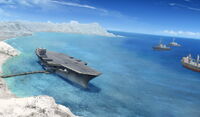
(TDA00) The USS John F. Kennedy and its support ships around it.
- The predecessor class of the Nimitz-class supercarrier, the Enterprise-class was the US Navy's first nuclear-powered carrier class. Originally built to launch planes, the onset of war against the BETA saw the carriers being retrofitted to launch TSFs instead. The Enterprise-class carriers are involved in long-term patrol missions; Enterprise and America constantly keep watch over the Mediterranean and England area, while John F. Kennedy, together with George Washington, were stationed at Yokosuka Naval Base in Japan as part of the assault force against the Cheorwon Hive during Operation Babylon in the Unlimited timeline.
- The John F. Kennedy had a crew complement of 3000, inclusive of 800 crew to pilot and service its TSFs, could carry up to 18 TSFs and 8 SH-60 helicopters, and was armed with four Phalnax 20mm CIWS guns. During the Battle of JFK, it carried only three F-18Es of the USMC Black Knives Squadron and nine F-18Fs of the US Navy's Raging Busters Squadron.
Nimitz-class Carrier[]
Ships of the line: CVN-68 USS Nimitz, CVN-69 USS Dwight D. Eisenhower, CVN-70 USS Carl Vinson, CVN-71 USS Theodore Roosevelt, CVN-72 USS Abraham Lincon, CVN-73 USS George Washington, CVN-74 USS John C. Stennis, CVN-75 USS Harry S. Trunman, CVN-76 USS Ronald Reagan, CVN-77 USS George H.W. Bush
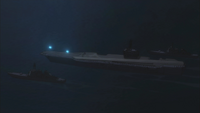
(TE An.) The Theodore Roosevelt launching TSFs from its flight deck.
- The supercarrier of the US Navy, the Nimitz-class was the first TSF naval carrier; its massive decks could support up to 40 TSFs, an as-of-yet unmatched number of TSFs a carrier can carry. The Nimitz-class was involved in a great many operations across the globe; Theodore Roosevelt supported Japanese forces during the Defence of Kyoto, and Nimitz provided support to allied forces during Operation Sledgehammer, to name a few.
- The first ship, Nimitz, was partially built when it was decided to integrate TSFs into the US Navy's strike groups and had to receive upgrades to allow it to launch TSFs, specifically F-11s and F-14s, instead of conventional planes. Later Nimitz-class carriers were built from the ground-up to support TSFs.
Gerald R. Ford-class Carrier
Ship of the line: CVN-78 USS Gerald R. Ford, CVN-79 USS John F. Kennedy (to replace CVN-67 USS John F. Kennedy), CVN-80 USS Enterprise (to replace CVN-65 USS Enterprise), CVN-81 USS Dorris Miller
The successor of Nimitz-class Carrier, and a new supercarrier for US Navy. But still under construction
European Carriers[]
Queen Elizabeth-class Carrier[]
Ships of the line: HMS Queen Elizabeth, HMS Duke of Edinburg, HMS Prince of Wales, HMS Ark Royal
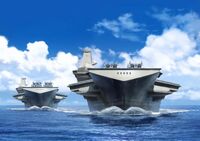
(Rain Dancers) HMS Prince of Wales and HMS Ark Royal.
- The Queen Elizabeth-class is the realization of the CVA-01 type of carrier ships that the United Kingdom constructed during the post-World War II period. When the BETA invaded Earth, the carriers were quickly converted to carry TSFs, and the four ships remain in service up till today. Because of their small size in comparison to later carriers like the Nimitz-class, the Queen Elizabeth-class can only carry up to six TSFs.
- The Prince of Wales and Ark Royal were deployed to carry the TSFs of the Rain Dancers squadron during the testing of the ESFP.
Invincible-class Carrier[]
Ships of the line: HMS Invincible
- The Invincible-class was an existing carrier type that saw conversion into a TSF carrier on the onset of the BETA invasion of Earth. As a former light aircraft carrier, its carrying capacity is even smaller than the Queen Elizabeth-class.
- Invincible was deployed with the Rain Dancers Squadron as the carrier of their helicopter attack group.
Trivia[]
- A point of interest is the replacement of the Kitty Hawk-class by the Enterprise-class as the ship type of the America and the John F. Kennedy. It is unknown for what reasons these two ships were built as Enterprise-class carriers instead of upgraded Kitty Hawk-class carriers.
- In the real world, the CVA-01 line of ships were never built. The real Queen Elizabeth-class Carrier is have a two island and only two in the class: Queen Elizabeth and Prince of Wales. Ark Royal is part of Invincible-class Carrier and Duke of Edinburgh never been in real life
References[]
- ↑ Integral Works, pg. 228, "日本帝国軍", "海軍".
Assault Ships, in this section, include ships of various classes that are purpose-built, or have the capability, to support the landing and/or cover of TSFs from sea to shore in any military operation. Unlike TSF Carriers, Assault Ships are not intended to support large groups of TSFs and any related seaborne operations; they carry TSFs towards a target on land via a nearby sea route to prevent pilot fatigue, fuel wastage, and exposure to Laser-class. Once they get close enough, they deploy their combat load and continue sea-to-land support operations from there.
Japanese Assault Ships[]
Ōsumi-class TSF Landing Ship[]
Ships of the line: Lead Ship Ōsumi (大隅), Takao (高尾), Okuma (大隈), Kunisaki (国東), Shimokita (下北), others

(MLA) Several Ōsumi-class of the IJN.
- The Ōsumi-class TSF Landing Ship, measuring 340 meters from stern to bow and with a beam of 66 meters,[1] armored with anti-projectile armor and anti-laser coating, is a landing support ship class deployed in great numbers by the Japanese Imperial Navy. Using a former supertanker design as basis, the Ōsumi-class, with its capability to carry up to four flights of TSFs, was built in order to to provide the IJN with landing operation support capabilities, and also to accommodate the terms of the US Security Treaty, which prevented the IJN from building regular carriers.[1]
- Despite its persisting nickname as a TSF carrier, the Ōsumi-class is only capable of rudimentary maintenance and resupply of TSFs, well below the level of logistics expected of true carriers. Its speed also left it unsuited for blue-water operations; it is considered a landing craft (that is exceedingly close to a transport ship) in terms of classification.[1]
- Ōsumi, Takao, and Kunisaki were present at Operation 21st, during the events of Alternative, while Shimokita was a participant in Operation Sledgehammer.
- The class' operational history in Unlimited/The Day After is not known.
American Assault Ships[]
Wasp-class Amphibious Assault Ship[]
Ships of the line: USS Boxer, others
- Wasp-class amphibious assault ships are capable of high-intensity support of local forces during operations against land targets as well as mass transportation of loads.
- Several were deployed to Japan after Operation Babylon to rescue Japanese refugees. Another ship, the USS Boxer, was home-bound from the European theater carrying both expeditionary Imperial Japanese and American forces when it encountered an enemy attack in Scotia Nova, and was subsequently destroyed in combat with French/Canadian forces.
Iwo Jima-class Amphibious Assault Ship[]
Ships of the line: Iwo Jima, others
- A modification of a World War II design, the Iwo Jima-class assault ship is a long-serving ship class of the USN.
- One was deployed to the naval regions of the Seattle Defence Line as an early-warning patrol ship, and was also the ship where Lilia Kjellberg, leading VMF-318 Black Knives, had launched from during the Defense of Seattle in 2004.
Soviet Assault Ships[]
Ivan Rogov-class Amphibious Assault Ship[]
Ships of the line: Ivan Rogov, Aleksandr Nikolayev, Mitrofan Moskalenko
- An amphibious assault ship capable of functioning both as a floating dock/shallow-water lander and also outfitted for beach landings, capable of carrying up to a battalion of infantry and their associated equipment.[2] As the ships lack the armor and anti-laser coating required of frontline engagements, they are mainly used as ferries for supplies and other military purposes between the front and rear lines.[2]
- During the events of Total Eclipse, a ship of this type ferried Argos Test Flight to the Kamchatka Peninsula for Project PROMINENCE's tenure there.[2]
Trivia[]
- Apart from visual and capability differences, while the Muv-Luv Oosumi-class assault ship share the same name with the real-world Oosumi-class tank-landing ship, both being named after Ōsumi Province, the ship in Muv-Luv is identified using the name of the province (大隅), while the ship class in the real world is identified in hiragana (おおすみ). The same difference in naming style is applied to the individual ships in both instances (eg. The ship name of Kunisaki is rendered as 国東 in Integral Works, but くにさき in real life.)
- In the real world, only Ōsumi, Kunisaki, and Shimokita exist as the three ships of their line, with no plans for others to be built; the other named ships, and their unnamed sisters in the Muv-Luv universe, are fictional.
References[]
Ranging from troop landers to logistic transports, these oft-unarmed vessels play an important backstage role in fleet strategy, transport, and logistics.
American Support Ships[]
LCAC-1[]

(MLA) LCACs of the United Nations.
- A hovercraft type, the LCAC-1 (Landing Craft Air Cushion-1) is a versatile amphibious craft that allows rapid transport of infantry, small-scale weapons systems, logistic needs, and other essentials from ship to land, or in the case of evacuation, from shore to sea. However, their small size means that these craft are not intended to engage in direct combat against BETA.
- The type' operational history in Unlimited/The Day After is not known.
Sacramento-class Support Ship []
Ships of the line: USS Seattle
- An older class of support ships.
Gopher State-class Support Ship []
Ships of the line: -
- A large support ship, the Gopher State-class handles the majority of transport, resupplying, freight, and other logistic needs in a fleet. One such ship was deployed with the John F. Kennedy and its battlegroup that was en route to Hawaii after Operation Babylon.
Submarines have taken on a radically different role from their past uses in the Unlimited/Alternative timeline, with their firepower more focused on launching bombardment attacks from the relative safety of underwater towards surface targets. American and Japanese submarines are also configured as tender craft to carry the A-6 Intruder, and, in the US Navy's case, as well as the A-12 Avenger, for use in establishing footholds on BETA-held shorelines during high-intensity assault operations.
Japanese Submarines[]
Type-81 Submarine Unit[]
Submarines of the line: Takashio, various others.
- A licensed production of the Skate-class, the Type-81 Submarine Tender (Japanese designation: 81式潜航ユニッ) is a submarine type deployed by the Imperial Navy. Capable of mounting a Type-81 Wadatsumi on its bow, the Type-81's main purpose is to launch the TSA while approaching the shoreline, and to aid allied units in the establishment of a land-based staging point alongside its assigned A-6J via sea-to-shore support fire and bombardment.
American Submarines[]
Swordfish-class Submarine Tender[]
Submarines of the line: -
- The first submarine tender, the Swordfish-class can mount one A-6 Intruder on its bow.
Los Angeles-class Submarine Tender[]
Submarines of the line: -
- A submarine class with improved uptime.
Soviet Submarines[]
Akula-class Submarine[]
Submarines of the line: -
- Soviet-production nuclear submarine, it is also identified by its NATO codename, the Typhoon-class. Before the BETA invasion, these submarines were an unwelcome reminder of Soviet naval power; now, they serve an important role ferrying supplies to the Mediterranean and providing armed support.
Trivia[]
- There is no actual Swordfish-class submarine; there is, however, a Skate-class submarine named the USS Swordfish. It is unknown if this is a mistake or intentional on the series' part.
- The Type-81 Submarine Tender and its series are fictional naval craft, as there are no JMSDF submarines in the real world with that class name. The only Type-81 that is named, the Takashio, has its real-world name counterparts in two separate classes of JMSDF submarines; the Uzushio-class, and the Oyashio-class.






![Udaloy-II class.png (1.92 MB) (TE-VN) An Udaloy II-class[9] of the Soviet Navy.](https://static.wikia.nocookie.net/muvluv/images/d/db/Udaloy-II_class.png/revision/latest/scale-to-width-down/120?cb=20130525022234)










